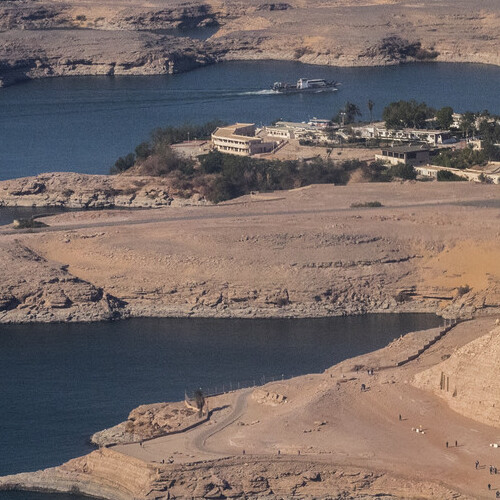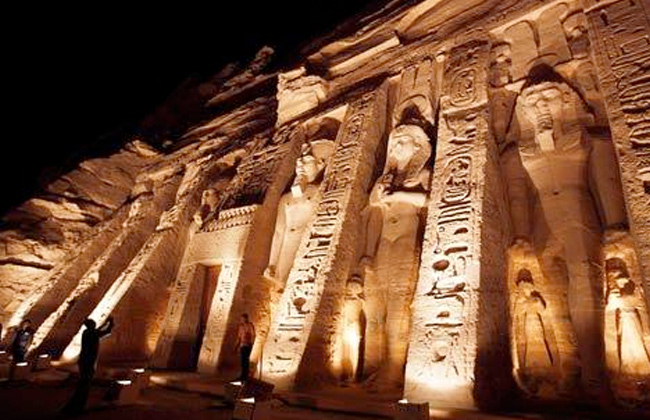No other nation in the world says ‘Welcome’ as often as the Egyptians, and every time, they mean it. While the ancient civilization of Egypt continues to amaze, contemporary Egyptians are equally remarkable.
Abu Simble Travel Guide
Abu Simbel Travel Guide – Where Eternity Meets the Nile
Rising majestically from the golden sands of Nubia, near Egypt’s southern border with Sudan, Abu Simbel is one of the most remarkable and spiritually charged monuments in the ancient world. Towering statues, intricate carvings, and extraordinary engineering come together here to tell a powerful story—one of legacy, ambition, divine kingship, and timeless reverence. For modern travellers, Abu Simbel offers not just a sightseeing stop, but a soul-stirring encounter with Egypt’s ancient heart.
During his reign in the 13th century BCE, Pharaoh Ramesses II, also known as Ramesses the Great, launched an ambitious building programme that extended deep into Nubia—a region rich in gold and other valuable trade goods. Recognising Nubia’s strategic and economic importance, Ramesses II sought to assert Egypt’s dominance and culturally integrate the region by erecting grand temples that displayed Egypt’s architectural genius and military power. The most extraordinary of these is the Abu Simbel temple complex, situated at what was then the Second Cataract of the Nile, marking the border between Lower and Upper Nubia.
Construction of the complex began around 1264 BCE and took roughly two decades to complete, concluding around 1244 BCE. The complex consists of two magnificent rock-cut temples:
What makes Abu Simbel particularly unique is the unprecedented depiction of Queen Nefertari standing alongside the pharaoh as his equal—an extraordinary gesture in ancient Egyptian art and ideology. The Great Temple’s façade, adorned with four colossal seated statues of Ramesses, each over 20 metres tall, is one of the most iconic images of ancient Egypt. The interior, just as awe-inspiring, is lined with massive pillars and intricate reliefs celebrating the pharaoh’s divine lineage and military victories, particularly the famous Battle of Kadesh.
Yet Abu Simbel’s story doesn’t end with ancient glories. In the 1960s, with the construction of the Aswan High Dam, the temples faced imminent submersion under the rising waters of Lake Nasser. In an unprecedented international rescue mission led by UNESCO, the temples were meticulously cut into blocks, moved to higher ground, and reassembled with astonishing precision. This modern engineering feat not only preserved a cultural treasure but added a new chapter to its legacy—making Abu Simbel a symbol of global cooperation and the power of human determination.
Today, Abu Simbel continues to enchant visitors from around the world. Every year, on February 22 and October 22, the sun rises and penetrates the sanctuary of the Great Temple, illuminating the statues of the gods seated within. This solar alignment phenomenon, thought to coincide with Ramesses II’s birthday and coronation, is a breathtaking fusion of science, spirituality, and architectural brilliance.
Whether you travel by air, join a Lake Nasser cruise, 4 Day Lake Nasser Cruise From Abu Simble or take the scenic road from Aswan, the journey to Abu Simbel feels like stepping into another world—one where the desert speaks, the stones remember, and history lives. Visitors often describe a profound sense of peace and reverence while walking among these ancient giants, far from Egypt’s bustling cities.
In the sections that follow, we’ll guide you through every aspect of planning your visit to this iconic UNESCO World Heritage Site—from when to go, how to get there, where to stay, what to pack, and the many experiences that await. Abu Simbel is not just a place to see; it’s a place to feel. A journey here is a journey to the very edge of civilisation, where the greatness of the past still casts its light upon the present.
- The Great Temple, dedicated to Ramesses II himself and to the gods Amun, Ra-Horakhty, and Ptah,
- And the Small Temple, built in honour of his chief wife, Queen Nefertari, and the goddess Hathor.
Yet Abu Simbel’s story doesn’t end with ancient glories. In the 1960s, with the construction of the Aswan High Dam, the temples faced imminent submersion under the rising waters of Lake Nasser. In an unprecedented international rescue mission led by UNESCO, the temples were meticulously cut into blocks, moved to higher ground, and reassembled with astonishing precision. This modern engineering feat not only preserved a cultural treasure but added a new chapter to its legacy—making Abu Simbel a symbol of global cooperation and the power of human determination.
Today, Abu Simbel continues to enchant visitors from around the world. Every year, on February 22 and October 22, the sun rises and penetrates the sanctuary of the Great Temple, illuminating the statues of the gods seated within. This solar alignment phenomenon, thought to coincide with Ramesses II’s birthday and coronation, is a breathtaking fusion of science, spirituality, and architectural brilliance.
Whether you travel by air, join a Lake Nasser cruise, 4 Day Lake Nasser Cruise From Abu Simble or take the scenic road from Aswan, the journey to Abu Simbel feels like stepping into another world—one where the desert speaks, the stones remember, and history lives. Visitors often describe a profound sense of peace and reverence while walking among these ancient giants, far from Egypt’s bustling cities.
In the sections that follow, we’ll guide you through every aspect of planning your visit to this iconic UNESCO World Heritage Site—from when to go, how to get there, where to stay, what to pack, and the many experiences that await. Abu Simbel is not just a place to see; it’s a place to feel. A journey here is a journey to the very edge of civilisation, where the greatness of the past still casts its light upon the present.

A very famous legend says that the temple and later on, the city was named Abu Simble after a local guy who was said led the arc haeologists to discover the complex. A trip to Abu Simble is extremely recommended to any tourists who are fond of ancient Egyptian architecture, natural scenery, and Pharaonic history.
Created On March 18, 2020
Updated On July 24, 2025







